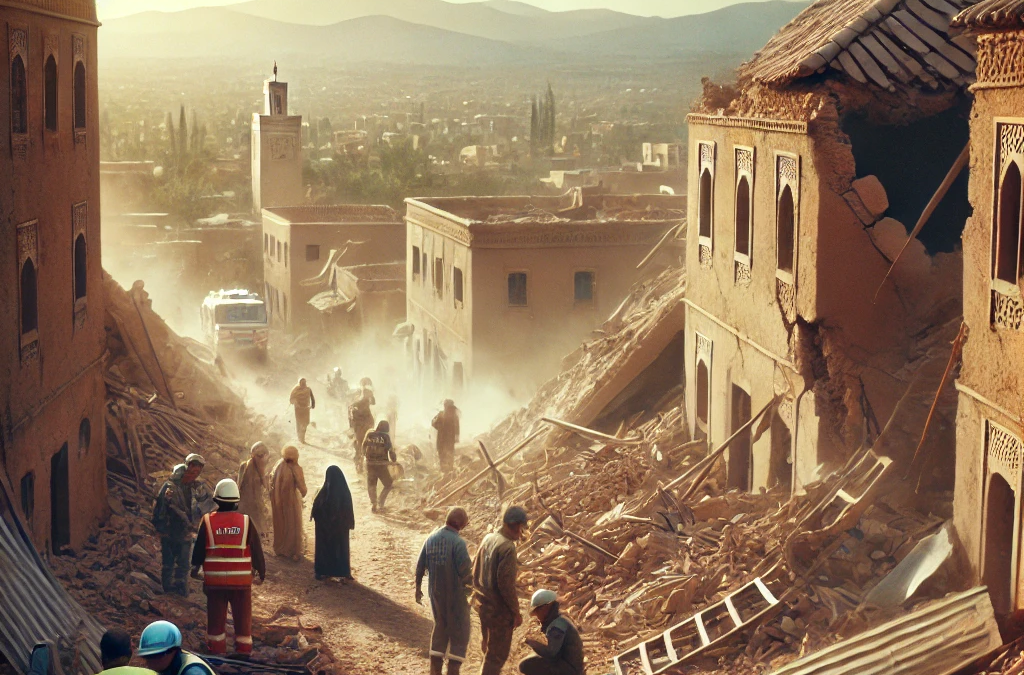Disaster struck Morocco in the middle of night on September 8, 2023. A little after 11 pm, a strong 6.8 earthquake in Al Haouz Province slammed the city of Marrakech and rural communities in the area. The temblor was the strongest to hit the region in over a century. It toppled walls and buildings, caused deadly rockfalls and landslides, and destroyed roads and power infrastructure. All told, the earthquake affected more than 600,000 people in Marrakech and beyond. Some villages, such as nearby Tafeghaghte, were nearly completely leveled. Officials estimate that 400,000 people lost their homes in the earthquake and became either temporarily or permanently homeless. In addition, 530 schools were damaged, preventing more than 100,000 children from continuing their education. Sadly, 3,000 people lost their lives and thousands more were injured.
After the aftershocks tapered off, Moroccans still suffered. Homes and sanitation infrastructure were destroyed, and people who had lost their homes crowded into makeshift settlements. Heavy rains soon flooded the camps and created a quagmire of mud in and around the tent cities.
International Response to the Morocco Earthquake
Recognizing the severity of the disaster and the widespread need in the area, international organizations jumped to respond to the earthquake. Volunteers and resources flooded into Morocco to assist with relief efforts. The initial focus was on ensuring a steady supply of food, potable water, shelter, and other necessities for people who had lost their homes and others affected by the earthquake. Medical care, blood drives, psychosocial support, and hygiene supplies were also provided. Rescuers and other first responders launched search and rescue efforts to recover survivors trapped under rubble and to retrieve the remains of those who perished.
As the acute phase of the disaster gave way to long-term recovery, other needs became apparent. With winter looming, people living in camps needed more protection from the elements. Roads and other infrastructure had to be repaired. Schools had to be rebuilt. Especially in rural villages, survivors still required ongoing food aid, clean water, and medical care.
Islamic Relief USA Contributes to Relief Efforts
The humanitarian aid organization Islamic Relief USA (IRUSA) has spearheaded relief efforts in Morocco since the earthquake. Working with local partners, IRUSA has focused on providing essentials like food and water, temporary shelters, mattresses, and bedding.
Among many other success aid initiatives in the region, IRUSA also paid for the construction of 40 modular homes. The modular homes were built in two styles, a two-bedroom model and a one-bedroom model. Both modular homes included a kitchen and latrine.
In January early this year, IRUSA contributed sleeping bags to the girls’ dorm at Commune Rural Timzguidiwine, providing winter-appropriate bedding for over 500 students. A medical convoy was also established in Tislit, Al Haouz, to provide health checkups and various medical treatments. At a school in Chichaoua, clothing (including jackets and warm clothes) was distributed to students and their parents in preparation for the coming winter 2024.
How You Can Help
Nearly a year after the earthquake, Islamic Relief USA continues to lead efforts and collaborate with local partners to provide relief to the people of Morocco. Anyone who wants to support these efforts can donate directly to IRUSA by going to irusa.org/middle-east/morocco.
